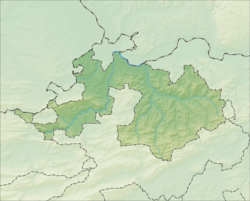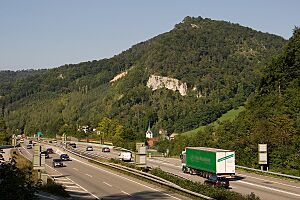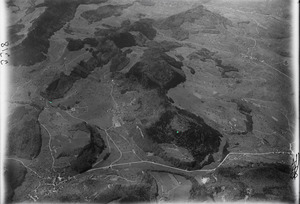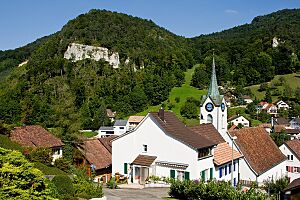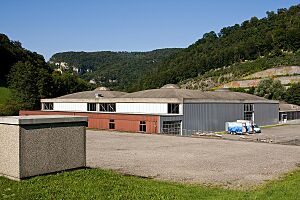Eptingen facts for kids
Quick facts for kids
Eptingen
|
||
|---|---|---|
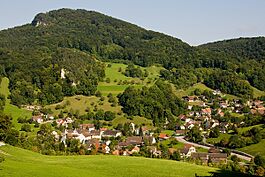 |
||
|
||
| Country | Switzerland | |
| Canton | Basel-Landschaft | |
| District | Waldenburg | |
| Area | ||
| • Total | 11.18 km2 (4.32 sq mi) | |
| Elevation | 568 m (1,864 ft) | |
| Population
(Jun 2021 )
|
||
| • Total | 544 | |
| • Density | 48.66/km2 (126.02/sq mi) | |
| Postal code |
4458
|
|
| Surrounded by | Bennwil, Diegten, Hägendorf (SO), Hauenstein-Ifenthal (SO), Langenbruck, Läufelfingen | |
Eptingen is a small town, also called a municipality, located in the Waldenburg district in Switzerland. It's part of the Basel-Landschaft canton.
Contents
A Glimpse into Eptingen's Past
Eptingen is quite old! The first time anyone wrote about it was in the year 1145. Back then, it was called Ebittingen.
Exploring Eptingen's Old Castles
Near Eptingen, you can find the ruins of an old hilltop castle called Burgruine Witwald. People also know it as Wild-Eptingen or the younger castle. This castle is located above the main settlement of Eptingen.
If you visit, you can still see parts of its old walls. There's also an entrance gate, a staircase, and a cistern, which is like an old water tank. About 300 meters (about 984 feet) to the southeast, you'll find even older ruins. These are probably from an earlier castle that came before Witwald Castle.
Eptingen's Coat of Arms
Every town has a special symbol called a coat of arms. Eptingen's coat of arms is yellow with a black eagle. The eagle is shown with its wings spread out, and its beak and claws are red. This design is called Or, an Eagle displayed fesswise Sable beaked and membered Gules.
Discovering Eptingen's Geography
Eptingen covers an area of about 11.19 square kilometers (4.32 square miles). A big part of this land, almost half (47.3%), is used for farming. Another large part (47.6%) is covered by forests.
The town itself, with its buildings and roads, takes up about 5.2% of the land. There are also a few small rivers or lakes, making up 0.1% of the area. A tiny bit (0.3%) is land that can't be used for anything.
Eptingen is nestled in the Waldenburg district. It sits at the bottom of the Belchen mountain, in a place called the Diegter valley.
Eptingen's Population and People
Eptingen has a population of about 527 people (as of 2023). Most people in Eptingen speak German, which is about 97.3% of the population. Some other languages spoken include Serbo-Croatian and Albanian.
In Eptingen, about 41.3% of the people were born right there in the town. Many others were born in the same canton (Basel-Landschaft) or elsewhere in Switzerland. About 9.9% of the people were born outside of Switzerland.
The population of Eptingen changes a bit each year. Sometimes more people move in, and sometimes more move out.
The chart below shows how the population has changed over many years:

Eptingen's Economy and Jobs
Eptingen has a low unemployment rate, meaning most people who want to work can find a job. Many people work in different areas:
- Primary sector: This includes jobs like farming and forestry. About 76 people work in this area.
- Secondary sector: This includes jobs in manufacturing (making things) and construction (building things). About 40 people work here.
- Tertiary sector: This includes jobs in services, like sales, transportation, hotels, and restaurants. About 174 people work in this sector.
Eptingen is famous for its mineral water brand, Eptinger. This water comes from the ground in Eptingen and is bottled there.
Religious Life in Eptingen
In Eptingen, many people belong to different religious groups. The largest groups are:
- Swiss Reformed Church: About 66.4% of the population.
- Roman Catholic: About 15.7% of the population.
There are also smaller groups, including Orthodox Christians and Muslims. Some people do not belong to any church.
Weather in Eptingen
Eptingen gets a good amount of rain or snow each year. On average, it has about 147 days with precipitation. The total amount of rain or snow is around 1,148 millimeters (about 45 inches) per year.
The wettest month is usually June, with about 120 millimeters (4.7 inches) of rain or snow. May has the most days with precipitation, around 14.5 days, but with a bit less rain overall. The driest month is October, with about 76 millimeters (3 inches) of precipitation.
Education in Eptingen
Many people in Eptingen have completed their education. About 37.8% of the population have finished high school (called upper secondary education in Switzerland). Also, about 10.1% have gone on to higher education, like a university or a specialized college (a Fachhochschule).
While some students from Eptingen go to schools in other towns, a few students from other places come to study in Eptingen.
See also
 In Spanish: Eptingen para niños
In Spanish: Eptingen para niños




